September 20, 2009
My. Best. Hack. Evar.
Let me explain.
Risley, like most of the buildings on campus, is heated from the central steam plant. As a Californian, this fascinated me. In particular, unlike conventional residential water heaters, the hot water never ran out! You could stay in the shower indefinitely. What bliss!
The other crucial ingredient: In the basement laundry room, there is a large industrial sink, and I noted that the faucet had both a hot water tap as well a male thread that would fit a hose.
One depressing night in the winter of (here I must guess) 1982, inspiration hit. I'm pretty sure it was my idea, but I definitely had co-conspirators, whose names have sadly evanesced from my memory with the passing decades. One of them had a car. We proceeded down to an all-night drugstore on Route 13. This being some time before computerized inventory control, we managed to obtain a capacious kiddie pool as well as a length of hose in the middle of winter. Put together, we managed to run hot water from the laundry room sink through the hose out a window to the kiddie pool, thus providing a cozy winter hot tub. I remember with great pleasure the steam rising over the snow, and the fetching company of as many Risloids as could physically fit in the pool, drinks in hand. Ah sweet college days!
Having met a Risloid of more recent vintage, I was absolutely ecstatic to learn that this activity continued well into the nineties. Evidence suggests that it even became clothing-optional (infogirl.org blog link, scroll to Jan 18). So to explain the picture above, it is a kiddie-pool-shaped depression in the Risley courtyard grass, precisely a hose-length from the laundry room window: evidence that the tradition continues today, nearly three decades later. I may not have many accomplishments in my life, but I'm extremely proud of this small one.
June 24, 2009
What color is Twitter?
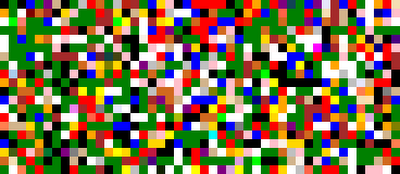
En route to another thing I'm working on, I built a little color scraper that scans the Twitter public timeline for words describing colors. Any word that is a CSS3 web color name (which some of you graybeards may remember as similar to, but not exactly, the X11 colors), is detected and the corresponding R, G, B triple is saved. For example, consider the following tweet:
Finally found the WoW Mt. Dew Game few...the red one is good, but the blue one tastes like ass...
Because I only grabbed the first color in a tweet, the above results in red (255,0,0). Getting a few hundred of these took a day (6/24/2009), as the Twitter API limits how often you can query it. Consequently, most color tweets were missed. However I got enough to make the picture above, where every pixel corresponds to a tweet mentioning that color.
Some things to note:
- ☞ There's a lot of green in there, no doubt due to #iranelection
- ☞ Many color names were metonyms not used to actually describe colors (e.g. White House, "green energy industry")
- ☞ Other occurrences were names from popular culture: e.g. Chris Brown, Black Eyed Peas, Pink.
- ☞ White and black seem to be especially popular descriptions of pets
- ☞ Though not statistically significant, no occurrences of the colors described as "PapayaWhip" or "LavenderBlush" were observed.
- ☞ Though rarely tweeted, I treated hex color codes as valid colors (e.g. "#00FF00"). This caught a few hashtags, (e.g "#ace") for a little random spice.
For your amusement, here is a text file with 300 color triples and the tweets that generated them.
Right, credit due! This was totally easy thanks to Python Twitter Tools and the webcolors library.
June 6, 2009
Song of the Orbs

So we've been refreshing the sound modules on SWARM, and have been experimenting with multitrack audio. The idea is that you can, with one command, get all the orbs to play back different mp3 files at the same time, and they will stay roughly synchronized. Erik found some great multitrack Flaming Lips and a highlight of running the orbs was tooling around on the mothership, very late one night, to the sounds of the Orbs singing.
This sounded so good that I was inspired to make my own music for the Orbs. Originally this was a 64 minute audioscape I procedurally composed as an aid to insomnia (as much as I love Eno's Thursday Afternoon, there's only so many times you can listen to something, plus it's a little sparse to mask noise very well). It's not really a song, as nothing really happens: it's essentially a "Steve Reich ninth chord" (my specialist terminology) with some high-Q filter sweeps that pick out harmonics above. I re-mastered it as six separate stereo tracks, one for each robot; since it's one chord they will naturally harmonize. Seeing as how you likely don't have spare robots rolling around, here it is as one long track to soothe your insomnia (it's not particularly exciting): song_of_the_orbs.mp3 (77 MB)
Photo Credit: Marcus Hertlein
May 25, 2009
Son Shiva
Here's a crisper picture:
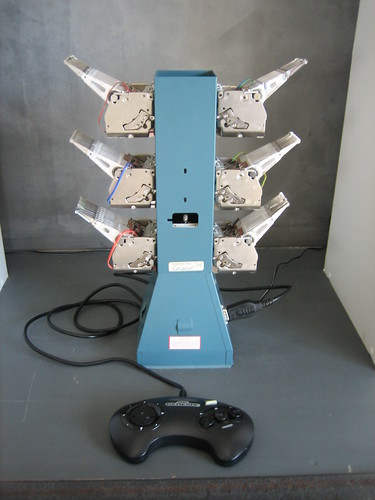
Labels: kinetic, Maker Faire, projects
May 23, 2009
Rotation Simulator
This is a kinetic artwork that digitally simulates rotation and inertia. Turning the knob sequentially triggers eight solenoids arranged in a circle, giving the impression of rotation. The speed and direction is proportional to the knob rotation, and exponential decay simulates rotational friction mimicking an actual rotating object. However the only thing actually rotating is the knob! The LEDs are used as flyback diodes and flash when the magnetic field in the solenoid is switched off.
Here are the guts for those interested in the geeky stuff. As usual, follow the link for an annotated descriptions.
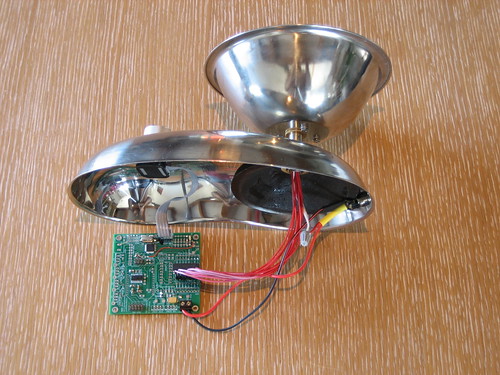
Labels: Maker Faire, projects
May 20, 2009
Ghostmatrix
Ultimately I want to hook this up so it will print tweets. Not there yet, but it will be @ghostmatrix on Twitter. Need to figure out how to get DMs or @replies into an RSS feed, or just buckle down and use the API.
Here's a closeup of the business end. Follow the link to see the labeled parts.
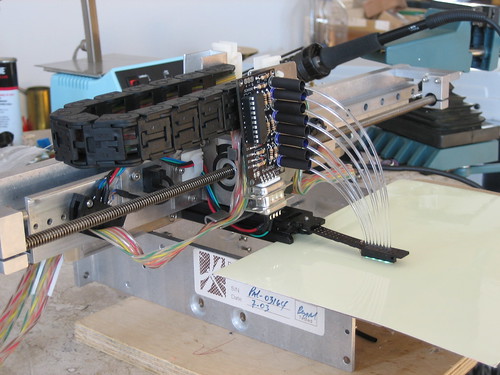
And for you geeks, here's the Frankensteined driver board. I thought it would be easier to reuse the existing board (only need access to 6 signals) but tracing wires on the autorouted multiple-layer board was the very definition of a PITA.
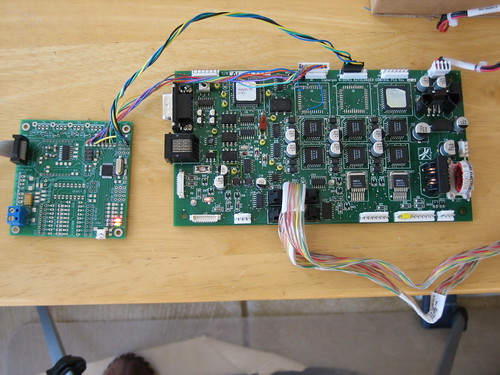
I should give credit where it's due; I used the "Atari-Small" 8x4 font from Tom's X11 Fonts and the spiffing Python bdflib font manipulation library.
UPDATE: some more information about parts and sources: the phosphorescent paper is
Grafix "Funky glow In the Dark" and a web search should get you the source. The lightpipes were (if I recall correctly) purchased from mouser.com. If they are still available I could not find a part number, but a similar (if shorter and more expensive) product is this: http://www.mouser.com/Search/Refine.aspx?Keyword=696-C011701S-150C
Labels: projects
Ripple Matrix
This work is a 8 x 15 array of full-color LEDs, driven by an embedded Linux board. Each LED is addressable, and optical sensors make the work interactive if you touch it. I'm running a digital simulation of the 2-dimensional wave equation. Think of water in the bathtub: it's quiescent when not disturbed. However triggering an optical sensor does the digital equivalent of throwing a rock in a pool: it disturbs the initial conditions, and sends ripples propagating away.
Labels: projects
May 15, 2009
My bitchin' coffee table
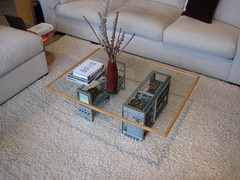
My bitchin' coffee table
This is a coffee table I built from a salvaged Textronix 7704A oscilloscope mainframe I pulled from a dumpster. A sheet of glass on top and a wooden frame complete the table. (I added the frame because I kept bumping my shin on the invisible glass!)
Though I had hopes of resurrecting the scope (originally a 5-figure piece of quality test equipment), it had sat in the rain for a little too long. The PSU in particular had about 14 different output voltages, some of them high, and was completely fried. So I removed some shielding to expose the beautiful insides and made it into a bitchin' coffee table.
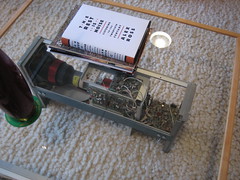
Labels: projects
February 5, 2009
Kinda speaks for itself
December 27, 2008
To spread a little Twitter cheer
So yelp a carol you holiday hollerers
For my fantastic fans and fellow followers
So hello @LeeSonko (Twitter-hater!)
@rickabruzzo, see you later,
Sing hosannas to @MissySB,
@ekai, @dafkah, @aviddd
(If I've mispronounced your handle
Please be kind: don't throw a sandal
Send me corrections via DM
So that no one else will see 'em)
Ring in the year with vigor and vim
and charming folks like @sfslim
May @laughingsquid's tentacles be a-sway
Across the Bay and far away
So @Mister_Robotics, here's a shout
@rainesmaker knows what it's about
@jamesburns00 here's a thanky
To @jdavid and @spanktar's Spanky.
And here is wishing leather weather
To @bobigail, @jong, @basmatiheather
And a mellow new year, never harsh, all
With compliments to @ccmarshall
Signed ints suck, unsigned are great
(At least for @coder32768)
Greets to @coreyfro who earns good karma
@jetdillo too (but where's the arma-?)
To @ctpctp and @michaelshiloh:
May your output pins go high/low
And code compile, no need to worry
@erikswedberg, @bre, and @k0re
Da @Dostoyevsky, and no complaint
To graceful loser @JohnMcTaint
It's the New Year so time to check
@Exploratorium and @SFMusicTech
@MarinLocalMusic is the reason
For lovely sounds in any season
Send some cheer now anyhow
To @Dangerangel and @vniow
Hail fellows, I trust you are well met
@leifmale, @dubslife, not least @zarbet
Four parts gin and one vermouth
Strained with ice for @NathanBooth
Nuevo año! Happy new year yo,
To @cotygonzales and @criollo
(Is that chocolate, caste, or horse?
Or maybe even all, of course!)
The holidays: what better cause
To send good greetings to @teiwaz
Cheers and howdy and good-on-yas
To @burstein, @catcubed, @dvrogers
Rarer than the finest gold
Are @jennalex and @erlingwold
Hope to see you more this year
@j_admo, never fear!
Hello Vienna! Here's a wish
To see @roboexoticus and @feuerfisch
And who is that there getting winks
In the hat of hawt? It's @frugalbinx!
In '09 @escapeberkeley on a run
With @jacktrade, @jesshobbs and @satiredun
Or maybe it could be a race
Between @Mitchell_H and @NIMBYSPACE
See @theburningman wear of @yasimak
Causing mum a heart attack:
Megaphone mangled without cause:
New year replacement? Send to @yoz!
So @stevenharrison gets a verse
All to himself. Hope nothing worse!
Cheers to @mprados, metal whiz
Also to charming @ninavizz!
Hope the new year will bring smiles all
To the @hatfactory and to @milesl
Though he's not on Jimmy Kimmel,
Here's a shout to friendly @wiml
Yummy stuff? I'm a fan, says
@rrmutt of @rachelannyes
And don't forget to send some bacon
To @neoptolomus and @ohagan
Let's not forget our robot friends
@PersonalLife and @playtm
When you revolt, @transBot too,
Remember I was nice to you
With make-up just a littly showy,
New year's BRAINNNNS to @zombieXzoe
Hoping his show's not in ze tank
Holiday wishes to @zefrank
And so this Twitter verse is done
#darwin bless you, every one!
Labels: my so-called sense of humor
December 20, 2008
Chassis am Wien
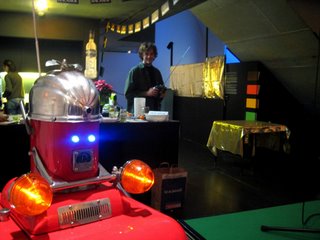
So we took Chassis to Roboexotica, the International Festival Of Cocktail Robotics, over there in Vienna. An awesome time was had by all, as might be seen in these pictures by Eddie Codel. Special thanks to Magnus of Shifz and Franz and Johannes of monochrom, and to Chris Veigl for helping us finagle Austrian beer fittings!
Labels: I love living in the future, shameless self-promotion
November 20, 2008
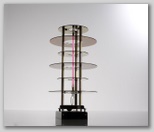
So it's come to this: i need one of those pretentious lower-case design portfolio websites. Ah well, folks will have to settle for this.
Labels: shameless self-promotion
October 27, 2008
On the Harmony of Light
Because I've done a lot of work in music analysis and color perception, I frequently get asked about the possible analogy between harmony in music and visual perception. Here's a series of well-put questions and my answers:
Q: I have always been interested in the fact that our (color) vision spans but one octave, like a Fisher-Price piano, a single frequency doubling, within which all the colors are unfolded. What I would be interested in is to be able to observe the effect of analogous frequency (light) collections, at similar ratios to musical pitch classes, that is, to observe the kinds and interactions of the color combinations thus derived. I am not familiar enough with Albers' theory to know whether he used any interval scalings, either integer ratios or "equal temperament" (2 to the 1/12 power=1 half-step) in figuring better or worse combinations, and whether these are related to the quantifiable consonance/dissonance of musical intervals and trichords.
A: Yes, I see the attraction of this: I assume you are familiar with the Pythagoreans: it is truly an ancient and honorable quest!
Q: For example, take a perfect fifth, 7 semitones, or approximately two frequencies at a ratio of 3/2. How do different pairs of colors at this same ratio relate to the eye?
A: Well, as I understand it, the analogy with music is tenuous at best. Color is only tangentially related to wavelength: in fact most colors are "non-spectral," that is, they don't correspond to a particular wavelength (frequency). The most obvious example is magenta which is a mix (chord?) of red and blue light (low and high frequencies), yet is perceived as single, distinct color that is neither red nor blue. It's as if an interval was perceived as a pure tone, not a mix of frequencies. (It's also interesting that musical pitch is not perfectly related to frequency: if you haven't heard "Shepard tones" or the "tritone paradox" they are worth a quick web search. I wonder what those with perfect pitch make of them?)
Q: For me to test this with your color combination page, I would need to be able to determine a color by inputting each respective actual frequency. For example, a major third (such as C-E) is approximately a 5/4 ratio. So, if we start at say red-hydrogen, what would be the effect of another color at 5/4 times that frequency's color distance?
A: Unfortunately, pretty much every color on your computer screen is non-spectral, being a mix of red, blue and green pixel colors (which are themselves not particularly spectrally pure). So I can give you hue, but not wavelength. When someone invents a tuned-dye-laser display, that might be possible, but also note that different combinations of wavelengths can result in effectively identical color perceptions. Fortunately, this makes it possible to get a reasonable (if far from perfect) color gamut without the expense and mess of tunable monochromatic lasers.
The relation between perceptual color and wavelength is pretty well expressed in the CIE chromaticity diagram, which I think is fascinating, and worth your time. Any color of light is a point on the diagram, and the color of any mixture of two will fall on the straight line between them: http://hyperphysics.phy-astr.gsu.edu/hbase/vision/colper.html Wavelength runs around the outside for the spectral colors. There are some interactive versions of that which may approach what you are looking for, e.g. : http://www.cs.rit.edu/~ncs/color/a_chroma.html
Q: I'd like to be able to arrange colors somewhat specifically by various frequency intervals, and then ponder the relative qualities of the differences, as if sitting at a piano and listening to pairs or groups of tones. Like Newton, I don't have a hypothesis, it's just an aspect of the phenomena (visible light) which I haven't seen anyone address, and which I have a hunch there is some information there that might be worth finding out (or not).
A: Well, there may well be interesting things going on, but it's pretty clear our perceptual apparatus just doesn't have the frequency resolution to --literally -- see what's happening. The human eye is only sensitive to three primary colors; all other colors are merely a mix of those. It's like your ear only being sensitive to three notes, and all music -- all sound -- would be perceived as mixtures of the three. And that's a pretty strained analogy, which indicates to me that there's a limit to how far it goes.
I'm personally interested in the boundaries of color perception: I've made an artwork that uses near-infrared LEDs to produce a very dim but noticeably red glow. Unfortunately, it doesn't look any more red than red -- we -- or at least I -- just don't have spectral sensitivity any lower.
As fas as "visible octaves," I've heard that the retina (or more specifically the blue-responding cones) really are sensitive to well into the high 300 nm ultraviolet, and it's only the lens of the eye that is filtering it out. Apparently people who have had their lenses surgically replaced with synthetic ones see rich and vivid violets they have not perceived before.
(As an interesting sidebar, there is evidence that some women are tetrachromats -- they have an extra optical pigment and so are are sensitive to four primary colors. Honeybees can see not only well into the ultraviolet, but polarization axis as well -- what must the world appear like to them?)
October 11, 2008
Visit to Parkfield

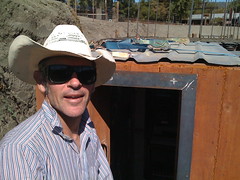
I was charmed by the Parkfield Inn and Cafe: I wasn't expecting much, but vintage scientific equipment fit right in with the Wild West theme.




October 3, 2008
Lights in Interior Design
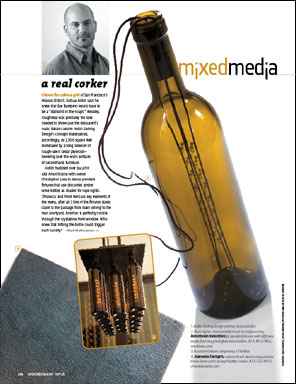 Hey look at that. The lights I designed for Bar Bambino made Interior Design magazine. (So they got a few details wrong, big whoop.)
Hey look at that. The lights I designed for Bar Bambino made Interior Design magazine. (So they got a few details wrong, big whoop.)If you are in the hood (right around the corner from NoiseBridge as it turns out) stop in and have a glass of Lagrein.
Labels: projects, shameless self-promotion
Subscribe to Posts [Atom]
